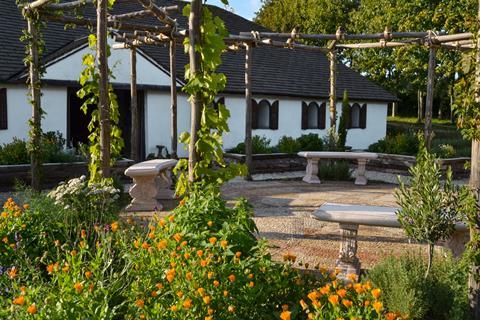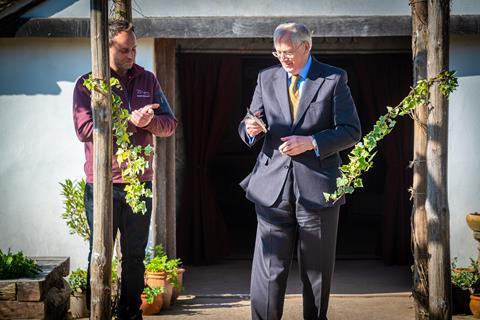The Duke of Gloucester has opened a new garden at the Hampshire-based open air museum, offering school groups a further glimpse into Roman life.

The royal visit coincided with celebrations to mark the 20th anniversary of the construction of Butser’s villa which is based on the archaeology of Sparsholt Roman Villa near Winchester.
To celebrate the milestone, a project was launched to create a formal Roman garden in front of the villa, representing the types of garden features and plants present in Romano-Britain.
“One of my favourite features in the garden is the rosemary hedging, not only does it smell beautiful, but it was also an important herb in Roman times.”
Kathryn Bingham, garden volunteer
The new garden at the farm near Chalton, includes sweet chestnut pergolas, stone benches, urns, raised flower beds and opus signinum paths, all elements known to have featured in Roman gardens, bringing history to life for pupils visiting on a school trip.

The original villa build was featured in a documentary series for the Discovery channel called Rebuilding the Past – something that hadn’t been attempted for 1,600 years.
Over the subsequent 20 years, the villa has undergone many developments and renovations as Butser Ancient Farm has grown to welcome thousands of school children through its doors.
Following the tour of the farm, which included seeing timber framing and metal-smelting in action, and meeting some of the excited pupils on their school trip, The Duke of Gloucester officially opened the garden and mosaic.
School visits to Butser Ancient Farm
Butser Ancient Farm is an open-air experimental archaeology museum and active research centre, which promotes learning about the past by recreating it.
The attraction covers the Stone Age, Bronze Age, Iron Age Celts, Roman, Anglo-Saxon and Viking eras, all located amongst the reconstructed ancient buildings.
The site can accommodate school groups of up to 200 pupils, with teachers benefitting from a free planning visit in advance of the school trip date and a choice of curriculum-based activities.
Highlights to look out for
The centrepiece of the Roman garden is a six-metre diameter circular mosaic floor, created by a team of volunteers using genuine Roman tesserae. These tesserae were originally part of a villa complex that happened to be in the path of the construction of the M4 motorway near Swindon in the 1970s. They were rescued from the bulldozers by a team of archaeologists and, last year, were donated to Butser Ancient farm to use in their experimental reconstructions.
Kathryn Bingham, Butser Ancient Farm garden volunteer, said: “It’s been fascinating to research and explore the types of plants the Romans used and brought to this country almost 2,000 years ago - many of which we still use for the same purpose today.

“One of my favourite features in the garden is the rosemary hedging, not only does it smell beautiful and attracts the bees and butterflies, but it was also an important herb in Roman times, known as the herb of memory and the renewal of energy.
“Washing with rosemary was said to be a natural method of keeping one’s youthful looks, and scholars would wear garlands of rosemary on their heads to improve their studies.”
Rachel Bingham, Butser Ancient Farm creative developer who led the garden and mosaic project, said: “It’s been a huge amount of work and a labour of love for the many staff and volunteers involved in bringing the vision to reality. The creation of the mosaic alone took over 300 volunteer hours of labour with an estimated 10,000 tesserae used in the design.
“It’s been amazing to work on something that we hope could itself last for thousands of years, just like the ancient Roman mosaics. Now that the garden is complete we are looking forward to seeing it being enjoyed by all our visitors and for it to continue to bloom and grow for years to come.”
For more information about school visits to Butser Ancient Farm, visit www.butserancientfarm.co.uk.










